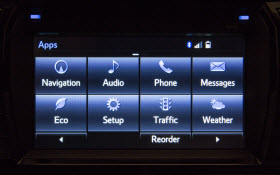NEW Power over Ethernet (PoE) Touchscreen Panel PCs for Patient Monitor & Medical-Grade Displays
Hill-Rom, a leading manufacturer and provider of medical technologies and related services for the health care industry has selected American Industrial Systems (AIS), a global leader in HMIs and digital signage display solutions, to supply their Power over Ethernet (PoE) touch panel mount PCs for hospital electronic signage solutions outside patient rooms.
Outside Patient Rooms Display, Digital Signage,Touch Panel with PoE Technology Allows Hospitals to Provide Better and Smarter Care to Patients (Photo: Business Wire)
Hill-Rom’s electronic signage solution utilizes the AIS 10.1″ touch screen panel PC computers for displaying digital messaging outside a hospital patient room and can help eliminate the need for paper signage that can be outdated and incorrect. The messaging can be updated manually or automatically, pulling from an HL7 feed. Messages can be personalized to the patient’s condition, to some extent. Some examples include information manually entered as patient notes, charted information, issued orders, documented allergies and messages for visitors.
The AIS touch panel PCs are extremely flexible, thanks to an open platform design. Utilizing an operating system of their choice, healthcare users and medical device companies can deploy an HMI solution that fits their unique and exact software programming requirements. In addition to their flexibility, AIS touch panel HMIs offer a host of PC-related features, including Windows-based, integrated CPU, RAM, data storage, USB, RS232, RS422/485 and Ethernet ports. Housed in a rugged, all-steel construction-designed enclosure for harsh industrial environments as well, the AIS PoE touch screen supports panel, wall and VESA mounting.
Poised to capitalize on the hospital patient monitor displays market, one of the fastest growing niches in the medical-grade displays segment in the healthcare industry, AIS offers the broadest ranges of touch screen panelPCs and HMIs available. AIS displays are suitable for a wide range of healthcare and medical-grade display applications, including patient self-serve monitors, bedside services, nurse-call systems, interactive public access kiosks, general digital signage displays and system control and office automation.
The ASI 10.1″ PoE touch screen panel PCs are also ideal for industrial machine manufacturing, process and discrete manufacturing, industrial automation, building automation and custom HMI applications. Featuring a 10.1″ industrial-grade LCD flat panel with resistive touch screen technology and NEMA 4 IP65 ingress protection rating front bezel designed for HMI display and visualization solutions, these displays simplify operator control and monitoring systems, PLC, HMI and SCADA applications for industrial users.
Nelson Tsay, President of American Industrial Systems, Inc., adds “The open platform design of our touch screen panel PCs delivers unmatched flexibility and performance for healthcare digital signage and patient display/monitoring applications. We are proud to be chosen by Hill-Rom for their hospital electronic and digital signage solutions.”
Headquartered in the USA, in Irvine, California, AIS is an ISO 9001:2008 certified supplier and manufacturer of rugged computer and display, and had received completion of the International Traffic in Arms Regulations (ITAR) registration from the Directorate of Defense Trade Controls (DDTC). AIS is an established global manufacturer of a wide range off-the-shelf and customized industrial-grade HMI and display products in different configurations for various industrial, military, and outdoor digital signage applications.
From:NJYTOUCH

